How to Run an Effective Sustainability Committee: From Structure to Action
Establishing a Sustainability Committee: A Roadmap for Success
Establishing a sustainability committee is a critical step for integrating and seeing success from environmental, social, and governance (ESG) principles into your organization. However, its effectiveness depends on how well the committee operates, who is involved, and how priorities are selected and executed.
This guide provides a comprehensive roadmap for running productive sustainability committee meetings, assembling the right team, implementing initiatives, and identifying material ESG topics to drive meaningful impact. The following sections elaborate on how to set up and run an effective sustainability committee, from meeting structure and team formation to executing impactful ESG strategies.
What Role Should an Internal Sustainability Committee Play?
Companies develop committees to help review, iterate and install sustainability strategies. Because sustainability is cross-functional, committees ensure it’s disseminated across the organization.
Committees can work in tandem with or instead a sustainability lead. Many companies also use an internal sustainability committee to support external consultants.
Related: Why Your Sustainability Committee Needs Executive Support to Succeed
Who Should Be on the Sustainability Committee?
A successful sustainability committee should have a diverse team with a range of skills, perspectives, and expertise. Here’s a breakdown of key stakeholders to involve:
1. Executive Sponsor
A senior leader who provides strategic direction and ensures that sustainability initiatives align with company goals.The executive sponsor’s role is to secure resources, advocate for sustainability and ensure the full backing of leadership.
2. Operations Lead
The operations lead integrates sustainability into the organization’s day-to-day operations. They help ensure sustainability is in production, supply chain, and business processes. Their involvement is essential for translating sustainability strategies into practical, operational changes.
Related: Why Private Equity is Prioritizing ESG in 2025
3. Finance Representative
Finance professionals are integral in assessing the financial implications of ESG initiatives. They check the cost-effectiveness of investments, identify funding sources, and assess the ROI of various ESG initiatives. Their input is vital for ensuring that sustainability goals are financially sustainable in the long term.
4. HR Representative
Human Resources drive the “S” initiatives like diversity, equity, and inclusion (DEI), employee engagement, and social impact.
5. Marketing/Communications Representative
Marketing and communications experts convey the organization’s sustainability efforts to stakeholders. Effective communication can build engagement, attract customers, and enhance the company’s reputation. They can craft messages around ESG initiatives and share progress with stakeholders.
6. Procurement/Supply Chain Lead
Sustainability in sourcing and supply chains is increasingly critical for organizations. A procurement lead can ensure that sustainability is prioritized in supplier selection, materials sourcing, and logistics. This role helps manage the environmental and social impact of the supply chain.
7. ESG/Sustainability Expert- internal or external
Having a dedicated ESG expert ensures the committee has specialized knowledge of environmental and social issues. Some companies keep this person as an internal role, where others rely on external consultants. This person guides best practices, regulatory requirements, and emerging trends in the sustainability space.
Q: What if my organization doesn’t have all of these roles?
A: Based on your material topics, size and industry, you might have different function areas or roles on the committee. Don’t be afraid to shift roles or functions in and out of the organization as your committee evolves.
Selecting Material ESG Topics
Identifying the most relevant ESG topics means the committee focuses on high impact areas only. Here are some strategies to help rank the right ESG topics:
1. Conduct a Materiality Assessment
A materiality assessment evaluates which ESG issues are most important to stakeholders like investors, employees, customers, and regulators. This process identifies where the organization can have positive impact and where to mitigate risks.
Related: Is it time for an ESG materiality assessment for your business?
2. Analyze Industry Standards
ESG frameworks like SASB (Sustainability Accounting Standards Board) or GRI (Global Reporting Initiative) help identify industry-specific priorities. Understanding the standards in your sector proves committee aligns with best practices.
3. Assess Business Impact
Determine which ESG topics align with your organization’s industry and operations. For example, if your company is a heavy energy user, reducing carbon emissions with energy efficiency is a priority.
4. Engage Stakeholders
Gather input from stakeholders to understand which ESG issues are critical. Regular engagement prioritizes areas driving value for the organization and its stakeholders.
5. Track Emerging Trends
Stay informed on evolving regulations and market trends that could influence ESG priorities. Staying proactive helps the committee expect and address challenges before they become problems.
Related: Why Your Sustainability Committee Needs Executive Support to Succeed
How to Get Things Done: Moving from Discussion to Action
Sustainability committees often face challenges in translating discussions into concrete action. Here’s how to ensure your committee’s meetings lead to meaningful outcomes:
1. Develop a Roadmap
A roadmap outlines the steps required to achieve sustainability goals or running metrics. Include clear timelines, roles, and responsibilities for each initiative. A step-by-step plan tracks progress and identify potential roadblocks early on.
2. Secure Resources
For initiatives to succeed, it’s essential to divide resources, both financial and human. The committee should work with leadership to secure necessary support, whether it’s funding for new technology or dedicated staff. Companies with roadmaps have a better chance of getting funding and resources.
3. Communicate Successes
Communicating successes, even small ones, helps to build morale and momentum. Share progress to reinforce the organization’s commitment and foster a sense of achievement. A company could hold an annul all-company meeting to provide a sustainability update, or 5 minutes of a monthly all hands.
4. Integrate with Business Strategy
Ensure that sustainability goals align with the organization’s broader business objectives. When sustainability is part of the company’s core mission, it becomes part of the long-term strategy, leading to sustained impact and value creation. A materiality assessment can help ensure your organization is tying sustainability to its core objectives.
Related: Crafting a Comprehensive Corporate Sustainability Policy: A Step-by-Step Guide
Running an Effective Sustainability Committee Meeting
A well-structured meeting is gives tangible results and creates momentum. Regular, clear, and focused meetings keep the sustainability committee aligned with its purpose. Here are the best practices for running an effective sustainability committee meeting:
1. Set Clear Objectives
The first step in organizing a productive meeting is to define clear objectives for each session. These objectives should align with the sustainability strategy of the organization. Whether reviewing ESG metrics, new initiatives, or resolving challenges, a clear purpose keeps meetings focused. For example, a meeting goal might be to assess renewable energy initiatives or discuss programs tied to community engagement. Clear objectives also provide benchmarks for measuring the committee's ongoing efforts.
2. Create a Structured Agenda
A well-thought-out agenda is crucial to organizing an efficient meeting. A structured agenda ensures critical issues are addressed while leaving room for new ideas and discussions. The agenda should cover:
Updates on Ongoing Sustainability Initiatives: This is a time to check in on the progress of existing projects and identify any challenges.
Discussion of New Opportunities and Challenges: This allows members to introduce new sustainability opportunities or concerns for discussion.
Progress on ESG Goals and KPIs: Tracking ESG goals highlights how well the organization is performing in its efforts. Reviewing key performance indicators (KPIs) should be an ongoing part of every meeting.
Delegation of Tasks and Responsibilities: Assign tasks and responsibilities for the next steps.
3. Assign Roles
Establishing clear roles helps meetings run and ensures companies see progress from initiatives. Key roles to consider include:
Chairperson: The chairperson leads the meeting, ensuring that objectives are met, and discussions stay on track. The chair is also responsible for ensuring all viewpoints are heard.
Secretary/Note-Taker: The secretary records notes, action items, and decisions. This role is essential for tracking progress and ensuring accountability. This role should rotate quarterly or annually.
ESG Subject Matter Experts (SMEs): SMEs provide technical expertise on sustainability topics. Their insights ensure that the committee’s decisions are informed and actionable.
Task Owners: These individuals provide updates on their assigned tasks. Task owners drive progress and are accountable for executing the initiatives discussed. This will include each person on the committee.
4. Encourage Engagement and Open Dialogue
A sustainability committee is effective when there is open dialogue and active participation. Encourage members to share insights, challenges, and ideas throughout the meeting. Open engagement fosters collaboration and allows the committee to identify opportunities. The chairperson acts as facilitator, preventing any one member from dominating the conversation.
5. Follow Up on Action Items
At the end of each meeting, the note-taker should summarize the action items. Distribute meeting notes with key points and deadlines to keep members accountable.
Q: How often should our committee be meeting?
A: Most committees should meet at least once a month, ramping that up or down depending on seasonality of both your business and initiatives. For example, the start of the year could be busier with end of year reporting and carbon accounting, while summer could be a time when meetings happen less frequently. A committee with clear objectives and a roadmap should use that to dictate the best meeting times.
Conclusion
A sustainability committee can drive real, lasting change when meetings are well-structured, the right stakeholders are involved, and clear action plans are in place.
By focusing on material ESG topics and ensuring effective execution, organizations can successfully embed sustainability into their core business strategy and create long-term value.
Strong leadership, transparent communication, and a commitment to measurable outcomes will ensure that the committee moves from discussion to meaningful, impactful action, helping to drive sustainable growth and innovation for the organization.
Check out more ESG topics



















